David Bird
Audits
Contact
Photos
The book
Introduction
Foreword
Contents
Chapter 9
Buy it

Front cover
Chapter 9
The Influence of Oak
Many strokes, though with a little axe,
Hews down and fells the hardest timbered oak.
Shakespeare, Henry VI Part Three
The influence of wood on wine is a complex and controversial subject. It is undoubtedly ancient in origin, as wooden vessels were in use long before concrete, fibreglass or stainless steel. Conversely, one must not forget that other materials were in use long before the technology of woodworking had been learned: animal skins, earthenware vessels, stone jars and troughs.
Oxygen plays an important role in the maturation of red wines in wood. Much of the character of fine red Bordeaux wines, for example, depends on the period of time they spend in oak barrels (Fr. barriques). During their sojourn in the barrels, the oxygen that gets in through the pores of the wood, around the bung and during the process of racking, attacks the tough tannins in the wine, causing them to precipitate and fall to the bottom of the barrels, leaving the wine softer and more supple. (See also p.37 Microoxygenation)
Oxygen also plays an important role in the stabilisation of the colours in red wine. At the end of the primary fermentation, oxygen is needed in the creation of stable colouring matter to enable the tannins and the anthocyanins to interact by a process known as `oxidative coupling'. This ultimately produces more stable colouring matter.
A secondary, and some would say the prime, purpose of using wood is the addition of extra flavours and therefore the increase in complexity of the wine. The degree to which these flavours are imparted to the wine depends on the number of times the barrel has been used and on the length of time the wine spends in the barrel. If maximum influence is required, new barrels have to be used, and it is not usual to find that the wine is in the barrel for only some eight months. New barrels are expensive, in the region of #300 each, so it is not surprising that wine that has been through a proper regime of fermenting and ageing in wood is also expensive.
105
Type of wood
There is a tendency to think of oak as the only wood used for making wine containers, but this is a somewhat narrow view, as other woods such as chestnut, beech, acacia and mahogany have been used. However, although these woods are perfectly good for holding wine, there is nothing to equal oak for its combined properties of storage and flavour. In fact, one might almost put flavour before storage, such is the demand for the characteristic nuances of vanilla and spice that good oak can bestow.
The correct use of oak is complex and involves many decisions, so it is worth looking into this topic more deeply.
Geographic Provenance
Oaks are members of a large family, the Fagaceae, which is actually the beech family. Within this family, the oaks belong to the genus Quercus, of which there are over 250 species, but only three of these are of any interest for the construction of barrels.

The most basic subdivision is between European oak and American oak. European oak is found in two distinct species, Quercus robur, the English Oak or Pedunculate Oak, and Quercus sessilis, the oak found in most of the French forests. American oak is Quercus alba, the best of which is found in Pennsylvania, Minnesota and Wisconsin. It is futile to make statements regarding the relative quality of the various oaks, as they each have different properties and serve different purposes.
Good European oak suitable for barrel production is produced in several countries, including Hungary, Slovenia, Romania, Russia, and
106
Poland, but France is probably regarded as the best source, if only because it has the largest reserves in Europe and the most varied. Quercus sessilis is generally regarded as the finest oak, as it has a tight grain and is rich in aromatic compounds. This is the species found in the Tronçais, Nevers, Allier and Vosges forests. Limousin is the only forest composed of Quercus robur, which has coarser grain and a lower aromatic content and is particularly useful for the ageing of cognac.
Size of vessel
It must not be forgotten that oak is used not only for barrels, but also for large vats as well for both storage and for fermentation. These upright vats are normally made in sizes between 10 and 200 hl, but can sometimes be found at 500 hl or even larger. The socalled ``largest oak vat in the world'' can be found in the town of Thuir in southern France, holding one million litres (10,000 hl).
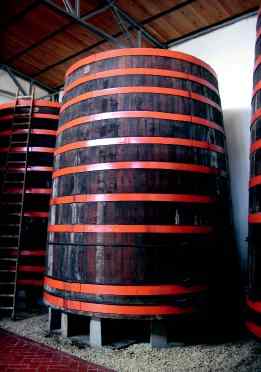
Large oak vats are used not for the benefit of oak flavour but for other reasons:
- good thermal insulation;
- oak tannins (ellagitannins) at a low level assist in the structuring of the polyphenols;
- low level microoxygenation assists in stabilising the colour of red wines;
- they look good!
Considering barrel sizes, the Bordeaux barrique of 225 litres seems to be regarded as the optimum capacity to give a sensible oak influence with ease of operation. The rate of change in a liquid always follows the same rule, that it is inversely proportional to the size of the container. This is because the changes occur at the interface between the liquid and the walls of the container, and the smaller the container, the greater the ratio of surface area to volume. Even in Hungary, where the Tokaji Aszu producers have traditionally used the 130 litre gonci barrel, the barrique seems to be gaining favour.
107
The choice of barrel size is important in relation to fermentation temperature. Smaller barrels, which have a greater surface to volume ratio than larger barrels, are more efficient at dissipating the heat of fermentation.
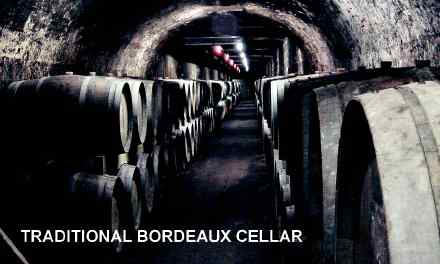
This is the reason why the traditional size of 225 litres was adopted in Bordeaux, being appropriate to fermentation in a cool cellar. Refrigeration is rarely needed, warming being more usual to prevent a fermentation stopping prematurely, where wines are still fermenting in the late autumn in a particularly cold season.
Seasoning and toasting
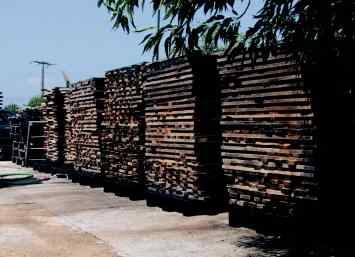 All oak has to be seasoned before use. This occurs after splitting into
stavesized pieces, when the moisture content is around 55%. After
three years this will have fallen to about 15%. In common with all other
forms of joinery, kiln drying is sometimes used but this
does not give a good result, giving astringency and green
characters to the wine from the rough tannins which are
cooked into the wood. Natural seasoning adds
elegance, richness and complexity to the wine, with
a smoother finish.
All oak has to be seasoned before use. This occurs after splitting into
stavesized pieces, when the moisture content is around 55%. After
three years this will have fallen to about 15%. In common with all other
forms of joinery, kiln drying is sometimes used but this
does not give a good result, giving astringency and green
characters to the wine from the rough tannins which are
cooked into the wood. Natural seasoning adds
elegance, richness and complexity to the wine, with
a smoother finish.
108
Toasting is a huge topic, with much research still in progress. To put it in basic terms, the greater the degree of toasting, the greater the influence on the flavour of the wine.
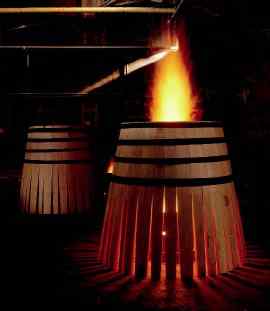 All barrels have to be heated in order to make the staves more flexible, so that
they can be bent into shape. This takes about 20 minutes, and the temperature
of the wood reaches between 120 and 180°C. This results in a light toasting
level. After another 10 minutes or so, the temperature will have risen to
about 200°C and gives a medium toast. A further 5 minutes produces a
temperature of 225°C and a heavy toast. At this stage the interior of the
barrel is deep black.
All barrels have to be heated in order to make the staves more flexible, so that
they can be bent into shape. This takes about 20 minutes, and the temperature
of the wood reaches between 120 and 180°C. This results in a light toasting
level. After another 10 minutes or so, the temperature will have risen to
about 200°C and gives a medium toast. A further 5 minutes produces a
temperature of 225°C and a heavy toast. At this stage the interior of the
barrel is deep black.
The resultant aromatic substances are many and complex. From the lignin in the wood comes the phenolic aldehyde vanillin, probably the best known and best loved added flavour. Other compounds produce aromas described as ``smoky, roasted, spice, clove, carnation etc.''
Other compounds derived from the hemicellulose in the wood produce yet more aromas: ``toasted bread, caramel, cocoa, coffee, sweet pepper, roasted almond etc.''
Fermentation in barrel
There has been an upsurge in barrel fermentation in recent years because it has been realised that better integration of oak flavours can be achieved by fermenting in the barrel, as opposed to merely ageing in the wood. This technique can be applied to red wines as well as white, although in the case of red the initial fermentation during the maceration has to be conducted in a vat in order to manage the flotation of the skins. Only after the must has been separated from the skins can the liquid be transferred to barrels for the completion of the fermentation.
An advantage of barrels over tanks is that an ample supply of oxygen is available for the first stage of fermentation, enabling the yeast to reproduce more rapidly because it is in its aerobic phase. This gives a
109
quick start to the fermentation and usually results in a higher alcohol in the finished wine.
The reactions going on in the barrel during fermentation are complex and have a major effect on the structure of the finished wine. The presence of yeast inside the barrel changes the interaction between wine and wood and plays an active role in the balance between fruit flavours and wood flavours. In the first instance, the yeast cells coat the inside of the barrel which reduces contact between wine and wood, and secondly, the yeast can absorb some of the wood extracts, changing them by a biochemical transformation into less aromatic compounds. The overall result is a more subtle and harmonious blend. Furthermore, the mass of yeast cells acts in a similar way to the polyphenols in red wine, protecting the wine from oxidation.
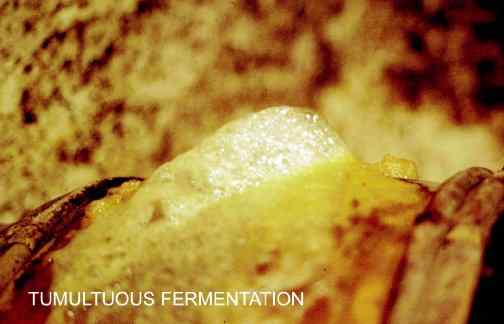
At the end of the fermentation there is the choice between racking the wine off the sediment or leaving the wine on the lees. In the latter case it is important that the lees are stirred periodically (Fr. bâtonnage), to prevent the risk of reductive flavours developing within the sediment. The mass of yeast cells has several further useful properties. As the yeasts die they release valuable substances known as polysaccharides, which act as natural fining agents, reducing bitterness from the wood tannins and thereby softening the wood flavours. They also increase complexity, improve the clarity of the wine, and prevent oxidation and an increase in colour.
110
The disadvantages of barrel fermentation relate to the cost of barrels, the difficulty of hygiene and the large amount of manpower involved in the handling of these comparatively small units. There is also a loss of freshness and of fruit, and an acceleration of maturity. So this mode of fermentation is only used for those white wines which have sufficient body and structure and are valued for their richness and complexity, and is not suitable for young fruity wines for early drinking.
Maturation in wood
Fermentation in a tank, with transfer to barrel after the completion of fermentation, does not produce quite the same effect. The various interreactions are less complex and the result is less subtle. The extraction of the many flavourproducing compounds from the toasted wood is more pronounced in the absence of fermenting yeasts. The oxidation of the polyphenols is also more rapid, since the protective effect of the fermentation process is absent.
Putting the wood in the wine
If all that is wanted is the extra flavours from the wood and not the oxidative maturation imparted by an expensive barrel, then rather than putting the wine into wood, the wood can be put into the wine in the form of chips (Quercus fragmentus?).
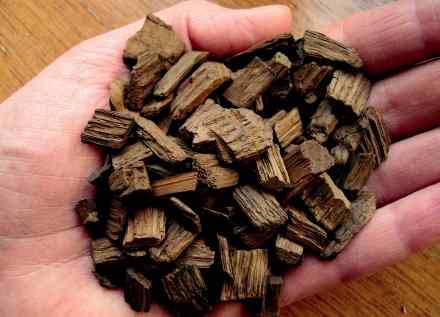
111
It is possible to buy chips of all the standard oaks, in all degrees of toasting, so the winemaker can reproduce the flavour profile of a barrel without the expense.
But -- the result is not the same. Obviously, the softening of the harsh tannins does not occur because there is no contact with oxygen. The oak flavours will be extracted, but they do not integrate in the same way as from a barrel.
And -- there is another drawback. It has recently been pointed out that their use is illegal in Europe for quality wines because they are not included in the list of permitted oenological practices, as listed in Regulation 1493/1999 annex IV. However, they are authorised experimentally for vins de pays. It's amazing how many experimental wines one finds on supermarket shelves!
112